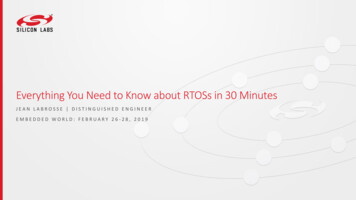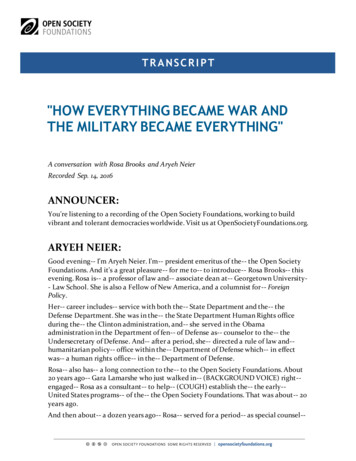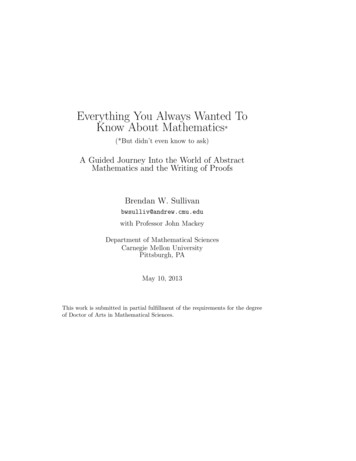
Transcription
Everything You Need to Know about RTOSs in 30 MinutesJEAN LABROSSE DISTINGUISHED ENGINEEREMBEDDED WORLD: FEBRUARY 26-28, 2019
An RTOS Allows Multitasking§ An RTOS is software that manages the time and resources of a CPU§ Application is split into multiple tasks§ The RTOS’s job is to run the most important task that is ready-to-run§ On a single CPU, only one task executes at any given timeTasks that are ready-to-runHighPriorityEventsSignals/Messagesfrom Tasks or ISRsRTOS(Code)LowPriorityTaskTaskTaskTask(Code Data Stack)(Code Data Stack)(Code Data Stack)(Code Data Stack)SelectHighest Priority TaskCPU FPU MPU(8, 16, 32 or 64-bit)silabs.com @silabs
An RTOS Provides Services To Your ApplicationOptional MiddlewareApplication(Code Data)(Code Data)(TCP/IP, GUI, File System, USB Stacks, Bluetooth, Etc.)RTOSTasksTimeSemaphoresEvent FlagsMutexesQueuesTimersMemory .)OSMemPut(.)::CPU FPU (opt) MPU (opt)silabs.com @silabs
Benefits of Using an RTOS§ Allows you to split and prioritize the application code§ The RTOS always runs the highest priority task that is ready§ Adding low-priority tasks don’t affect the responsiveness ofhigh priority tasks§ Tasks wait for events§ Avoids polling§ RTOSs make it easy to add middleware components§ TCP/IP stack§ USB stacks§ File System§ Graphical User Interface (GUI)§ Etc.silabs.com @silabs
Benefits of Using an RTOS§ Creates a framework for developing applications§ Facilitate teams of multiple developers§ It’s possible to meet all the deadlines of an application§ Rate Monotonic Analysis (RMA) could be used to determine schedulability§ Most RTOSs have undergone thorough testing§ Some are third-party certifiable, and even certified (DO-178B, IEC-61508, IEC-62304, etc.)§ It’s unlikely that you will find bugs in RTOSs§ RTOSs typically support many different CPU architectures§ Very easy to add power managementsilabs.com @silabs
Drawbacks of Using an RTOS§ The RTOS itself is code and thus requires more Flash§ Typically between 6-20K bytes§ An RTOS requires extra RAM§ Each task requires its own stack§ The size of each task depends on the application§ Each task needs to be assigned a Task Control Block (TCB)§ About 32 to 128 bytes of RAM§ About 256 bytes for the RTOS variables§ You have to assign task priorities§ Deciding on what priority to give tasks is not always trivial§ The services provided by the RTOS consume CPU time§ Overhead is typically 2-10% of the CPU cycles§ There is a learning curve associated with the RTOS you selectsilabs.com @silabs
Tasks§ For each task:§§§§§§YOU assign a priority based on its importanceRequires its own StackManages its own variables, arrays and structuresIs typically an infinite loopPossibly manages I/O devicesContains YOUR application codeCPU STKMyTaskStk[MY TASK STK SIZE];void MyTask (void *p arg){Local Variables;Task initialization;while (1) {Wait for Event;Perform task operation;}I/ODevice(s)(Optional)Task(Priority)// Task Stack// Task Code// Infinite Loop (Typ.)Stack(RAM)VariablesArraysStructures(RAM)// Do something useful}silabs.com @silabs
Creating a Task§ You must tell the RTOS about the existence of a task:§ The RTOS provides a special API: OSTaskCreate() (or equivalent)void OSTaskCreate (MyTask,//&MyTaskStk[0],//MY TASK STK SIZE,//MY TASK PRIO,//::);Address of codeBase of stackSize of stackTask priorityCPURegisters§ A Task Control Block (TCB)Device(s)(CPU FPU MPU)(Optional)Task(Priority)§ The RTOS assigns the task:§ Its own set of CPU tures(RAM)silabs.com @silabs
RTOSs Are Event DrivenHigh Priorityvoid EachTask (void){Task initialization;while (1) {Setup to wait for event;Wait for MY event to occur;Perform task operation;}}TaskTaskEventOccursWait ForEventTaskTaskTask§ Only the highest-priority Ready task can executeTask§ Other tasks will run when the current task decides to waits for its eventTask§ Ready tasks are placed in the RTOS’s Ready List§ Tasks waiting for their event are placed in the Event Wait List TaskLow Prioritysilabs.com @silabs
Tasks Waiting for Events Are Placed in a Wait ListDMA CompletionSemaphoreTask waiting forDMA to completePrinter AccessMutexTask waiting toaccess printerTask waiting toaccess printerHigh PriorityTick List(Delta List)Task waiting fortime to expireShortest Delay or TimeoutTask waiting toaccess printerLow PriorityTask waiting fortime to expireTask waiting fortime to expireLongest Delay or Timeoutsilabs.com @silabs
RTOSs Are Preemptivevoid Low Prio Task (void){Task initialization;while (1) {Setup to wait for event;Wait for event to occur;Perform task operation;}}void ISR (void){Entering ISR;Perform Work;Signal or Send Message to Task;Perform Work; // OptionalLeaving ISR;}void High Prio Task (void){Task initialization;while (1) {Setup to wait for event;Wait for event to occur;Perform task operation;}}RTOS t ForEventHigh Priority TaskRTOSResumesTaskLow Priority TaskLow Priority TaskTimesilabs.com @silabs
Interrupts Must Notify the RTOS§ Oftentimes, interrupts are events that tasks arewait for§ Interrupts are more important than tasks§ Assuming, of course, that interrupts are enabledNo schedulingEnter Signal ExitISR Level 3EventOccurs§ Kernel Aware (KA) ISRs:§ Need to notify the RTOS of ISR entry and exitISR Level 2§ Allows for nesting ISRs and avoid multiple schedulingvoid MyISR (void){Entering ISR;:Signal or send a message to a MyTask;:Leaving ISR;}§ ISRs can be written directly in C on Cortex-M CPUsSchedulingEventOccursISR Level 1EventOccursTaskRTOS resumes which task?TaskOR?Tasksilabs.com @silabs
A Context Switch Occurs When the RTOS Decides to Run Another TaskTask StackTask Stack(RAM)(RAM)CPU Registers FPU trolBlock(TCB)CPUFPUContextSwitchExample using Cortex-M4silabs.com @silabs
Most RTOSs Have a Periodic Time Source§ Most RTOS have a time-based interrupt§ Called the System Tick or Clock Tick§ Requires a hardware timerTyp. 1 ms§ The System Tick is used to provide coarse:§ Delay (or sleep)§ Timeouts on Wait for Event RTOS APIsTypical RTOS Tick§ A System Tick is not mandatory!§ If you don’t need time delays or timeouts you canremove it5 ms17 ms3 ms5 ms§ Typically interrupts at regular intervals§ Not power-efficient§ Dynamic tick (a.k.a. tick suppression) is more efficientDynamic RTOS Tick§ Requires reconfiguring the tick timer at each interruptsilabs.com @silabs
RTOS Services – Time Delays (i.e. Sleep)§ A task can put itself to sleep by calling RTOS APIs:§ OSTimeDly()// Delay for N ticksvoid Task (void){Task initialization;while (1) {Sleep for ‘N’ ticks;Do work;}}§ OSTimeDlyHMSM() // Delay for Hours, Minutes, Seconds, Milliseconds§ Can be used to wake up a task at regular intervals§ Control loops§ Updating a display§ Scanning a keyboard§ Letting other tasks a chance to run§ Etc.TaskN Tickssilabs.com @silabs
RTOS Services – Sharing a Resource Using a Mutex§ What is a resource?void EachTask (void){Task initialization;while (1) {::Acquire Mutex;Access the resource;Relinquish the Mutex;:}}§ Shared memory, variables, arrays, structures§ I/O devices§ RTOSs typically provide resource sharing APIs§ Mutex have built-in priority inheritance§ Eliminates unbounded priority inversionsTask§ There could be multiple mutexes in a system§ Each protecting access to a different resourceTaskAccess2SharedResource(Memory or st()TaskTimeoutsilabs.com @silabs
RTOS Services – Signaling a Task Using a Semaphore§ Semaphores can be used to signal a task§ Called from ISR or Task§ Does not contain datavoid TaskEventISR (void){Clear interrupt;Signal Semaphore;}void Task (void){Task Initialization;while (1) {Wait on Semaphore;Perform )TaskTimeoutsilabs.com @silabs
RTOS Services – Signaling Task(s) Using Event Flags§ Event Flags are a grouping of bits used to signal theoccurrence of more than one events§ Signals from ISRs or Tasks§ Only tasks can wait for eventsvoid TaskEventISR (void){Clear interrupt;Signal Event Flag Group;}ISRvoid Task (void){Task Initialization;while (1) {Wait on Event Flag Group;Perform work;}}EventFlagGroupWait for ‘ALL’ ofthe desired ��Flag(s)TaskTimeoutTaskWait for ‘ANY’ ofthe desired ��Flag(s)TaskTimeoutsilabs.com @silabs
RTOS Services – Sending Messages to Task(s)§ Messages can be sent from an ISR or a task to other task(s)§ Messages are typically pointers to data§ The data sent depends on the applicationvoid ReceiverTask (void){Task initialization;while (1) {Wait for Message;Process data;}}Producers§ The data must remain in scope until no longer referencedTaskSendISRvoid SenderTask (void){Task initialization;while (1) {Produce data;Send to er(s)TaskTimeoutDatasilabs.com @silabs
Debugging RTOS-Based Systems – µC/Probe, Graphical Live Watch § Seeing inside an embedded systemYourCodeRTOS(Optional)§ Non-intrusiveIDECompilerAssemblerLinker.ELF§ Display or change ANY values numericallyor graphicallyDebugger§ A universal tool that interfaces to ory & I/OAccessCDF (I/Os)§ 8-, 16-, 32-, 64-bit and DSPs§ No CPU intervention with Cortex-M§ Requires target resident code if not using thedebug port:§ RS232C§ TCP/IP§ USBCSF (Custom Symbols)§ For bare metal or RTOS-Based applicationsµC/Probe§ Micrium’s RTOS and TCP/IP awarenesssilabs.com @silabs
Debugging RTOS-Based Systems – µC/Probe, Graphical Live Watch Micrium’s µC/ProbeTM§ RTOS awareness§ Task state stack usage§ CPU usage§ Run counters§ Interrupt disable time§ Kernel objects§ Etc.§ Built-in 8 channel oscilloscope§ Display live data in Microsoft Excel§ Scripting§ Joystick Interface§ Multimedia support§ Etc.silabs.com @silabs
Debugging RTOS-Based Systems – Segger’s SystemView§ Displays the execution profile of RTOSbased systems§ Displayed live§ Trigger on any task or ISR§ Visualizing the execution profile of anapplication§ Helps confirm the expected behavior of yoursystem§ Measures CPU usage on a per-task basis§ Min/Max/Avg task run time§ Counts the number of task executions§ Display the occurrence of ‘events’ in yourcode§ Traces can be saved for post-analysis orrecord keepingsilabs.com @silabs
Do You Need an RTOS?§ Do you have some real-time requirements?§ Do you have independent tasks?§ User interface, control loops, communications, etc.§ Do you have tasks that could starve other tasks?§ e.g. updating a graphics display, receiving an Ethernet frame, encryption, etc.§ Do you have multiple programmers working on different portions of your project?§ Is portability and reuse important?§ Does your product need additional middleware components?§ TCP/IP stack, USB stack, GUI, File System, Bluetooth, etc.§ Do you have enough RAM to support multiple tasks?§ Flash memory is rarely a concern because most embedded systems have more Flash than RAM§ Are you using a 32-bit CPU?§ You should consider using an RTOSsilabs.com @silabs
Development Tools and Books§ Silicon Labs Integrated Development Environment (FREE):§ software/simplicity-studio§ Silicon Labs Development Boards:§ mcu§ Silicon Labs / Micrium OS Kernel (FREE when using Silicon Labs chips):§ software/micrium-os§ Micrium’s µC/Probe, Graphical Live Watch (FREE Educational Version):§ https://www.micrium.com/ucprobe/trial/§ Segger’s SystemView (FREE Evaluation Version):§ https://www.segger.com/downloads/free-utilities/§ Micrium Books (FREE PDF downloads):§ https://www.micrium.com/books/ucosiii/silabs.com @silabs
Thank you!SILABS.COM
§An RTOS is software that manages the timeand resourcesof a CPU §Application is split into multiple tasks §The RTOS’s job is to run the most important task that is ready-to-run §On a single CPU, only one task e











